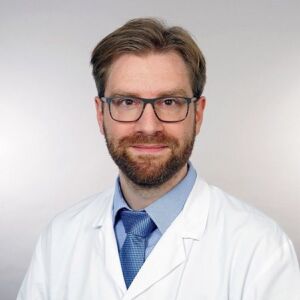Epilepsy surgery is performed in Zurich at the Swiss Center for Epileptology and Epilepsy Surgery (ZEE), a cooperation between the Department of Neurosurgery and the Swiss Epilepsy Center at the Lengg Clinic, the Department of Neurology at the University Hospital Zurich, and the Children’s Hospital Zurich. Thanks to innovative clinical research, we can offer state-of-the-art diagnostics and treatment methods. For example, by measuring high-frequency potentials (HFO) in the brain, it may be possible to identify and remove epileptogenic zones even better.
We are practically the only center in Europe to perform amygdalahippocampectomy (AHE) via a supracerebellar transtentorial approach, which does not cause any injury to the visual radiation in the temporal lobe with subsequent visual field restriction due to the surgical approach from behind.
Curative epilepsy surgery
Temporal resections
We perform selective transsylvian amygdalahippocampectomy (AHE) according to Yaşargil as a standard procedure for patients with temporal lobe epilepsy and suspected hippocampal sclerosis. It is the most common procedure for adult epilepsy patients.
Parts of the amygdala, hippocampus and parahippocampus are removed. The other structures of the temporal lobe are completely spared. The chance of becoming seizure-free is around 70%.
In addition to amygdalahippocampectomy, 2/3 resections of the temporal lobe are also performed. In addition to the structures mentioned above, the anterior part of the temporal lobe is also removed.
Extratemporal resections
This refers to the removal of an epileptogenic area outside the temporal lobe. The most common causes are abnormalities of the brain (focal cortical dysplasia) or epileptogenic, benign tumors or vascular malformations such as cavernomas.
In certain cases, electrodes are inserted between the brain and meninges or directly into the brain before the focus is removed in order to confirm the origin of the seizure or to precisely localize suspected epileptogenic areas. The electrodes allow stimulation to be carried out even in very eloquent brain areas such as the speech centers, the centers for movement and for emotional perception, in order to define their extent and relationship to the epileptogenic focus. This improves the planning and safety of surgical removal.
In addition, aids such as neuronavigation, intraoperative measurement of brain waves (ECoG), intraoperative neurophysiological monitoring or high-resolution ultrasound are used. For patients with tumors, high-resolution intraoperative imaging with 3Tesla MRI is also used to aim for maximum tumor resection.
Palliative epilepsy surgery
If drug and surgical treatments do not sufficiently reduce the number and/or severity of epileptic seizures, there are electrical stimulation procedures in the field of non-curative epilepsy surgery that can improve the seizure condition.
These are patients who have already undergone epilepsy surgery without sufficient success or in whom non-operable areas of the brain are causing the epilepsy.
Two neuromodulative surgical methods are used here to interrupt the epileptic brain waves: Vagus nerve stimulation (VNS) and deep brain stim ulation (DBS, Deep Brain Stimulation). In both methods, impulse generators (neurostimulator, pacemaker) send their electrical impulses via special electrodes either directly into the thalamus (anterior thalamic DBS) or indirectly into the brain via the tenth cranial nerve next to the left carotid artery (VNS).
From a surgical point of view, the procedures are very different when it comes to attaching the electrodes, namely by means of stereotaxy (DBS) or microsurgery (VNS). The pacemakers, on the other hand, are inserted into the subcutaneous fatty tissue on the abdomen or under the collarbone and connected to the electrodes.
The severity and form of the epilepsy are decisive factors in selecting one of the two surgical options as part of the interdisciplinary treatment team and offering it to the patient.
Both treatment methods are very safe interventions, so the opportunities and risks must be weighed up individually and brought into line with the level of suffering and possible side effects: It is not possible to predict the effect of either procedure, although the chances of seizure reduction with VNS are around 30-50% in half of patients with a focal seizure origin and 50-70% with DBS.
Once the cost approval has been obtained from the health insurance company, the operation can be performed electively. In the following months, the pulse generators are programmed depending on the effect and side effects together with the adjustment of the medication.
Typical therapeutic effects associated with an improvement in quality of life are the reduction of
- the frequency of seizures
- the duration of the individual seizures
- drowsiness after seizures
- of the medication
